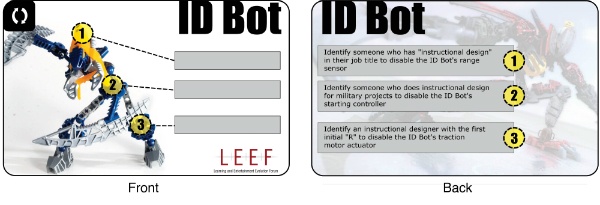Story And Player Types In Alternate Reality Game Design
Andy Petroski, Emerging Technologies Leader and Author, is allowing our readers to read portions of his work. This article comes from his book Alternate Reality Games: Gamification For Performance.
Stories in TV and movies are mainly meant to entertain. An Alternate Reality Game story should be entertaining, but also needs to be functional. The story needs to draw the players into the game and create a bridge between non-player characters, media elements, other players, digital activities, and the gameplay that takes place in the real world.
Robots Are Eating The Building: An Example
In the Robots Are Eating The Building ARG (discussed here), the story of the robots was used to kick off the game during the opening session of the conference.
With all the conference attendees in the auditorium, the host directed everyone to a pretend “live” feed from the security desk (it was a recorded video). The security area was being introduced as a hub for information and directions if attendees needed assistance during the conference. The video showed a standard CCTV security video display with four separate feeds from various parts of the building.
As the feed from the security desk was being highlighted and emphasized as a place for information and directions, the other feeds began to go fuzzy and out of focus. Screams were heard in the background. Text replaced the video feeds to proclaim, “Robots Are Eating the Building! Play If You Dare!!!”
Med Bot, Mil Bot, Ed Bot, Biz Bot, Consult Bot, and ID Bot were then introduced as the robots eating the building. A URL where conference attendees could register to play was displayed as the final screen of the video.

CCTV-like video image from the Robots Are Eating the Building ARG / Credit: Andy Petroski
The story was used to draw the players into the game. It also provided additional context to the cards in the attendee packets that players used to participate in the game. Attendees were given game cards for each robot that included 3-5 pieces of information that needed to be collected from the other conference attendees to defeat that robot. The robot story also promoted gameplay by providing a theme and overarching goal (defeat the robots and save the building).

Credit: Andy Petroski
The story provided a gateway for talking with conference attendees from different industries as part of conference activities. A scavenger hunt without the story would not have been as much fun and would not have resulted in the integrated theme that provided gameplay purpose and motivation.
Game On
The story for an ARG should provide direction and context for gameplay. It should address both personal and group goals. The ultimate player reward may be winning the game, winning a prize, or receiving some other sort of recognition. But, the story goal should be about saving the day, discovering a new opportunity, or overcoming adversity, both at an individual and group level. The story ties together the gameplay elements and the interactions between players and non-player characters (NPCs).
The ARG story is not only important for immediate motivation, engagement, and purpose. It’s also important for long-term learning and behavior change. Stories connect with our emotions, something that is usually lacking from traditional training, performance change, or employee engagement initiatives. Emotional experiences are memorable experiences.
Player Types
In addition, the story presents opportunities to satisfy the different ways in which individual players might interact with the game. There is a well-established player psychology model used to classify players of Multiplayer Online Games called the Bartle Test.
Created in the late ‘90s, the Bartle Quotient calculates a level of preference in each of four categories; Killer, Socializer, Achiever, and Explorer. Like any psychological profile, an individual is not one “type” versus another, but a combination of types with some types being stronger than others.
The Bartle test reminds us that there are a variety of player types and that the more types the game mechanics and story can address, the more likely it is the game will appeal to a broad audience. At the same time, specific player types can also be targeted through game mechanics and story for specific audiences.
1. Killers
Killers thrive on extreme competition and prefer player-to-player challenges, versus collaboration in gameplay. This player type likes to have an impact on the game environment by either deconstructing it (yes, blowing it up) or constructing it (building their own personal space). Killers also like to control gameplay either through dominating other players via the game mechanics, the social sphere of the game, or the game marketplace.
The Killer player type creates player-to-player action in the game. The ARG story and game mechanics can address the Killer player type by presenting frequent opportunities for “wins”, pitting players against each other or providing ways to impact the strategy of other players.
Player-to-player trivia competitions or single player mini-games, the results of which might allow the ability to reduce or stop other players’ progress, are examples of opportunities for “wins” that can be written into the story and game for Killers. The story and game design should also account for Killers potential disruptive behavior if they get bored.
2. Socializers
Socializers like to interact with other players or characters. A game is primarily a social mechanism for them. Rather than achieving a win-state, collecting, or exploring, Socializers play games for the relationships that result from gameplay.
Relationships? Can you create relationships by playing games? Sure you can. Games can provide player-to-player interactions and player-to-non-player character interactions (quasi-relationships). Many games also involve a community of players (physical and/or digital) that discuss, collaborate, and trash-talk around the gameplay.
Like movies and television, players discuss the game’s plot, the characters, and what they would do if they were the producer. Video game players also discuss tips-and-tricks, Easter eggs, and cheat codes. The ARG story should include characters and ways to “interact” with those characters (physically or virtually) for Socializers.
The ARG game mechanics should allow player-to-player interactions as part of gameplay or in support of playing the game. There can be opportunities for players to physically gather as part of the story and game. Or, there can be discussion threads, live chats, web conferencing, and a variety of other opportunities for players to interact in the ARG. The design of social interactions should be purposeful, however.
Socializers like to... socialize. Design the social elements of the ARG story and game so that Socializers don’t turn the ARG into the company water cooler with a 100% focus on socializing.
3. Achievers
Achievers are collectors... of anything and everything. Points, badges, tools, and levels all represent success in the game to Achievers, whether or not the collection of those items impacts the final outcome of the game to any degree. Achievers are competitive like Killers, but are more focused on competing against the game and themselves versus other players. The story’s focus on solving a problem or achieving a final goal is important to Achievers.
Collection of achievements needs to be balanced with a challenge for Achievers. Although the focus of their competitive nature is not on other players per se, Achievers do like to be recognized as successful in the game.
And extra opportunities that can be presented to Achievers based on their success are also coveted. The ARG story and game mechanics should include a variety of opportunities to achieve success and have that success represented in the game for Achievers. Layers and branches of the story that may only be accessed by those that achieve a certain level or status should also be considered for this player type. Collecting items, solving puzzles, playing trivia games, unlocking clues, and completing levels are game mechanics that appeal to Achievers. And, consider a time-based element to completing tasks with more points given to those that complete the task the quickest.
Achievements, recognition titles, scoreboards, and leaderboards round out the Achievers’ experience as ways to represent their success in the game to others. Design the story and game so that achieving isn’t the only focus though. And, don’t make achieving too easy. Achievers like the success, but they also like the challenge.
Scoreboards and leaderboards can be considered differently. Scoreboards show a player’s number score, usually a cumulative score, in relation to other players. A leaderboard can show top performers in sequence, but usually by a designation other than number score. Leaderboards can be cumulative, but can also show the most active, most efficient, or most collaborative players for only a segment of gameplay. Example: A scoreboard displays: Player 1 = 2,305 points; Player 2 = 2,065 points; Player 3 = 1,904 points. A leaderboard displays: Player 1 = Level 11 | 3 badges; Player 2 = Level 10 | 5 badges; Player 3 = Level 10 | 2 badges
4. Explorers
Explorers are the fourth and final player type category in the Bartle Quotient. Explorers like to play the game within the game. They like to find hidden treasures, alternate pathways, Easter eggs, and unknown glitches.
The backstory of characters, the environment, and the current state are important to Explorers. It gives them context from which to plan their own exploration during gameplay. Variety is also important to Explorers. It’s the reward for exploring; finding something new or unique. The ARG story and game mechanics should provide opportunities for “wandering” to appeal to Explorers. Consider hidden non-player characters, non-descript resource indicators, and vague innuendos in the story and gameplay to keep Explorers interested.
Consider how to keep Explorers on task in the ARG if you have learning and performance objectives throughout. Otherwise, Explorers will find the hidden gems within the game, but may not achieve the knowledge, skills, or attitude change that the ARG is targeting.
My Bartle Quotient is Achiever=67%; Killer=60%; Explorer=47%; Socializer=27%. My gamer DNA is A-K-E-S! Goals and rewards are what drive me. But, I also like the adventure and, every-so-often, some collaboration and interaction with other players does me good. Like most personality tests, the quotient does not define us as one thing versus another. We all have a bit of every personality- or player-type in us. But, there is a dominant way in which each of us approaches life and gameplay.
The consideration of all player types in the Alternate Reality Game design and story makes it more likely that everyone who plays will enjoy the experience at some level. An audience analysis may also reveal that the targeted players of the ARG at your organization may prefer a certain type of gameplay.
For example, one might assume that accountants are Explorers, Sales people are Killers, and nurses could be a combination of Socializers and Explorers. However, it’s dangerous to make generalizations.
Ultimately, a thoughtful audience analysis is needed to determine whether you want to target specific player types in your story and gameplay or create an ARG experience that will appeal to everyone in some way. A thorough audience analysis, including one done through the lens of the Bartle player types, is recommended before creating the ARG story and game mechanics.






